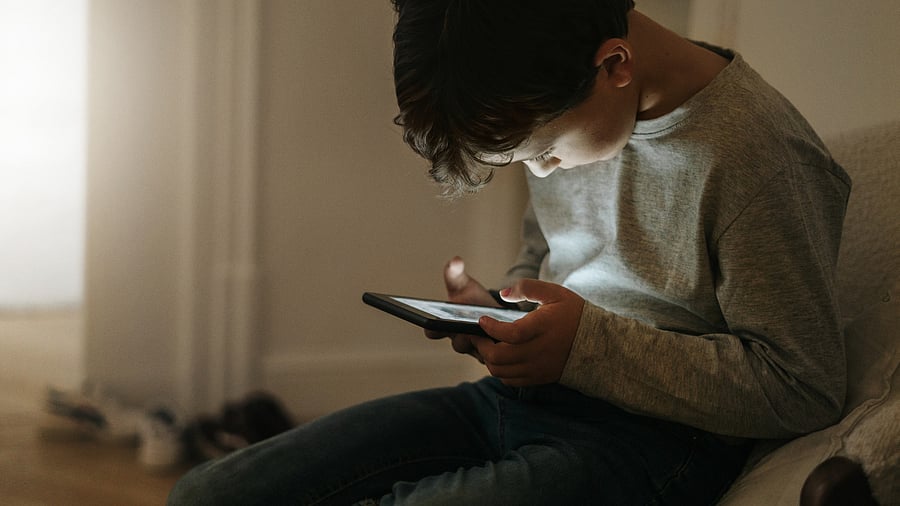
Representative image of a kid using phone.
Credit: iStock Photo
By Parmy Olson
Something sounded off about Mark Zuckerberg’s impromptu apology (non-apology) at a US Senate hearing earlier this month to parents whose kids had been harmed by social media. It wasn’t just his expression of regret “for everything you’ve all gone through,” rather than Facebook’s behavior. It was his weak defense at the end. “This is why we invested so much and are going to continue doing industry-leading efforts to make sure no one has to go through the things your families had to suffer,” he said.
Zuckerberg knows full well that in the absence of serious regulation, his investments in safety have always played second fiddle to growth. In that sense, social media firms can’t be expected to police themselves, but there’s hope that in the meantime, a flurry of new laws and plucky grassroots movements are steering things in a more promising direction.
It only took a matter of days, for instance, for a movement to recently explode in the UK from a WhatsApp group whose parents didn’t want to give phones to their soon-to-be high schoolers. Hampshire-based Clare Fernyhough set up the group with her friend Daisy Greenwell because she was worried about growing social pressure to buy her 9-year-old daughter a smartphone. Given their addictive nature and the documented harms of social media, there seemed to be no good reason for getting one — other than that everyone else was.
“We set up a group who felt the same, that parents were sleepwalking into giving phones without questioning it,” Fernyhough tells me. When a friend posted about the assemblage on Instagram, it went viral. About 2,000 people joined in the first two days, hitting WhatsApp’s participants limit. The parents split everyone into 50 regional groups, like Oxfordshire, Cambridgeshire and Hampshire, and within a week they had 10,000 members, many of whom were splintering into school-specific WhatsApp communities.
Seventy-three parents are now in a group established for Fernyhough’s daughter’s primary school, representing about a quarter of the pupils there. Many have expressed relief, says Fernyhough, at finding others who want to delay purchasing phones until their kids are much older, like 14.
Her goal is to get 30 per cent of parents in every primary school in the country to make the same commitment, creating a greater sense of choice among themselves and their kids. “If we’ve got one in three delaying phones, then you’re not completely on your own,” Fernyhough says.
Similar grassroots activities in America are being led by schools that found the prevalence of these devices in classrooms stunted learning and impeded relationships. Those efforts likely gained steam after the US surgeon general last year warned that social media carried “a profound risk of harm” to children. Around the same time, the state of Florida passed a law compelling public schools to ban smartphones during class time, and nationwide school bans were already being encouraged or enforced by law in the UK, Italy and China.
Campaigners like Emma Lembke, a college student who started the LOG OFF movement to help young people create healthier relationships with social media, have continued lobbying politicians and raising awareness among teens about holding off on smartphones, or using them without social media apps.
Of course, commitments from schools, parents and pupils to delay using phones can only go so far. This technology is designed to be addictive. That’s why it’s heartening to see more lawmakers addressing the root of the problem with ambitious regulation.
On Monday, Canada’s government introduced a law that will force social media companies to better regulate and remove harmful content. Known as the Online Harms Act, it will make platforms like TikTok and Instagram responsible for reducing children’s exposure to posts that bully or sexually victimise kids, or that incite extremism, violence or hatred.
The law is similar to the UK’s pioneering Online Safety Act, which gives tech firms a “duty of care” to prevent harm to users, drawing inspiration from health and safety law to help avoid infringing freedom of expression. America’s proposed bipartisan kids online safety bill is designed around similar principles. (Despite having more than 60 backers in the Senate, it still faces uncertainty in the House of Representatives.)
These are all signs of progress and not a new moral panic, as some have argued. Although it’s true that there were 18th-century complaints about novels swaying young people toward destructive behavior, or modern worries about video games, rap CDs and comics, the tools of this era are fundamentally different.
The level of access to smartphones is unparalleled in history, offering almost unlimited content. And apps often use psychological tactics like infinite scrolling and variable rewards to encourage compulsive behavior. It’s little wonder that Americans check their phones an estimated 144 times a day on average.
It may be a few more years before social norms shift to a healthier state and new laws take effect, but critical efforts have been made across the board recently that make the future look more hopeful than before.